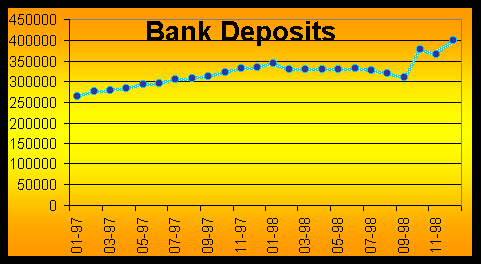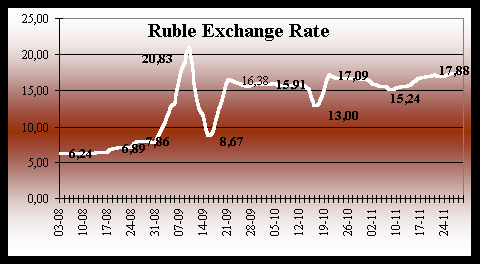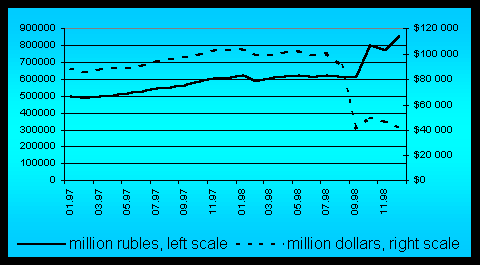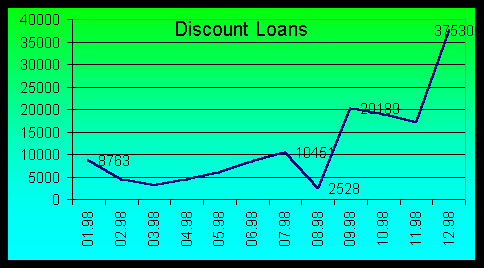It might seem to an outside observer that the financial crisis and the government default on its obligations were the major factors that caused Russian banks to suspend their payments to one another and to their depositors and clients. It is a factor but not the main one. Many analysts, and bankers themselves, assign the consequences of the crisis to the trends in the financial system prior to the mid 1998.
So what are those factors and trends that have led banking community to the shame of bankruptcy? Let us start from the very beginning - the emergence of the Russian banking system. Private banking in Russia became legal shortly after the state bank - GosBank - was split in 1989 into separate functional banks (Sberbank - saving bank, VneshTorgBank - international trade bank, etc.). The banking sector then virtually exploded - fueled with cheap "development" discount loans from the Central Bank the industry mushroomed and topped 2500 banks in 1994 (TS). From the very start of their history bankers became accustomed to "easy money": first, that were FOREX speculations, when the discount loans were used to buy hard currency. When the CBR finally stopped subsidizing the banks and started supporting the ruble instead, the number of revoked bank licenses proliferated and the number of "banks" decreased. In 1996 another "easy money" instrument emerged for the effeminate Russian banks. When the federal government no longer was able to finance its deficit with monetarization, the government securities market was created. Banks once again enjoyed unproportionally high income on government short-term securities - GKO. The share of the government bonds in the banks' assets started increasing in 1996 and very fast gained 30 - 35 % of the assets (CBR). Yet the euphoria did not last long. In 1997 the CBR managed to lower the interest rate and the banks' profits tumbled down. To improve their profitability somehow banks, especially larger ones, started to engage in the FOREX forward market, hedging exchange rate risks of foreigners who still played with GKOs. In all, strictly speaking, Russian banks have never been traditional banks by a textbook definition - channeling funds from depositors to creditors. They were simply speculators.
Situated in an environment of constantly decreasing profitability, the banks had a limited ability to attract more sources of funds, to compensate this decrease in profitability by increase in volume. For example, through January to August 1998 aggregate bank deposits of individuals, businesses, and governments had decreased 23.3 billion rubles or 6.77 % (see graph 1).
Graph 1: Aggregate Bank Deposits, mln. rubles

Source: costructed based on CBR statistics at www.cbr.ru; 1999
Given little luck on the domestic market of deposits, Russian banks, especially large ones, turned their views outside Russia. Starting March 1999, Russian banks borrowed from the foreigners more than they lent to them. Net foreign assets, the difference between international assets and liabilities, had been decreasing through all 1997 and the first half of 1998 and was in the low of minus $8 billion on August 1st 1998, with $ 20.4 billion of foreign liabilities and 12.4 billion of assets (see graph 2). In all, the share of the foreign obligations constituted 16.0 % of aggregate bank assets (CBR).
Graph 2: International Assets and Liabilities of Russian Banks, $ mln

Source: costructed
based on CBR statistics at www.cbr.ru; 1999
Given a stable ruble exchange rate Russian banks also became involved in the ruble forward market, hedging exchange rate risks of foreign investors on the Russian government securities market. Although at first this source of profits turned out to be significant, with time it was becoming less and less profitable. To offset the consequent fall in profits banks started to build up their forward obligations (RBC). In result, total forward contracts of the commercial banks (without Sberbank) on August 1st, 1998 was 87.9 billion rubles, or considering expected then exchange rate of 6.2 – 6.4 RR/$, about $14 billions, which constituted 86 % of aggregate banks' capital (CBR).
These three major trends - GKO holdings, increase in dollar denominated liabilities, and forward contracts - turned to be the major starting point for consequent losses to Russian banking community.
As we all well know, on August 17th, 1998 GKO were frozen, the ruble started its journey down. According to the Central Bank, in August alone banks' capital got lighter 13.5 billion rubles or 13.2 %; losses were 6.8 billion rubles (CBR). Business deposits surged 7.1 billion rubles (15.5%) and $1.8 billion (23%). In search for liquidity the banks had to limit their loans: outstanding loans decreased 8 billion rubles (8.4%) and $ 2.8 billion (22.1%) (CBR). Individuals' Deposits, bln rubles Uncertainty and increasing risk of the industry led to the stoppage of interbank market operations, thus making the efficient redistribution of loanable funds unavailable. During August the volume of inter bank loans fell 6.1 billion rubles (35.6%), and $230 million (9.5%) (CBR).
Graph 3: Individuals' Deposits, billion rubles

Source: costructed based on statistics
of GosKomStat /www.cbr.ru/; 1999
To add fuel to the fire, a banking panic started nationwide. From August through October, individuals' deposits fell 25.1 billion rubles, or 15.6 % from the level prior to the crisis (See graph 3). Deprived of their secondary reserves, that is GKO, banks started experiencing serious liquidity problems. Dynamics of banks reserves validate this: the level of bank reserves decreased recent history low in September - October 1998. Reserve ratio had its minimum in October of 14.4 % (reserves/total deposits) - 5.8 percentage point reduction since August (See graph 4). The first that suffered from the liquidity problems were banks' corporate clients: their payments were delayed. Businesses started changing their bankers from those that have major liquidity problems to less problematic.
Graph 4: Bank Reserves, mln. rubles, right scale; and Reserve Ratio, left scale

Source: costructed based on CBR statistics at www.cbr.ru; 1999
Alone with the GKO default and ruble devaluation, August brought a three month debt moratorium for Russian banks in respect to their obligations to foreign creditors. According to RosBusinessConsulting, although the authors of the moratorium had best intentions in their minds, the decree created more problems than solved. Those banks that were able to pay their foreign obligations did so despite the decree, not willing to dump their international credit ratings. On the other hand, the banks that could not pay, did not even intend to pay them neither during the span of the moratorium, nor after it was to expire on November 17th. They used the time to grind their own axe taking funds from the control of their creditors and the Central Bank.
As for the situation with the forward contracts, although the moratorium did not explicitly spelled out that this kind of contracts are also subject to the decree, "when a first round of forward contracts came due on September 15th, most Russian banks did not paid their [forward] debts, citing the moratorium" (Bershidsky). For those banks that did pay their forward contracts the Central Bank took a significant interventions into the forex market to prop up the ruble. On September 15th the ruble gained in value significantly from 20.83 rubles per dollar on September 9th to 8.67 on September 15th. (See graph 5).
Graph 5: Ruble Exchange Rate: August - November 1998

Source: costructed based on CBR statistics at www.cbr.ru; 1999
On October 12th, three days prior to the second round of the forward contracts, "the CB once again came to the rescue of the Russia's floundering commercial banks, offering them relief from payment on ruble forward contracts ... conducted with other Russian banks and with the Russian resident subsidiaries of foreign banks" (Bershidsky). It also repeated the trick with increasing ruble exchange rate, to lesser extend though: some speculators were expecting this and was going to counter play on the Central Bank's intentions. That time the ruble strengthened to 13.00 rubles per dollar, almost 2 rubles change on the day earlier.
Despite the default of the Russian Government and then of Russian banks, the situation did not get critical for the defaulters. The Central Bank of Russia discouraged the foreign creditors from suing Russian banks: "Mr. Gerashchenko's comment that the greedy would get nothing, was taken seriously" - said The Moscow Times newspaper (Daigle).
Graph 6: Aggregate Bank Assets 1997-98

Source: costructed based on CBR statistics at www.cbr.ru; 1999
Taking into consideration, that Russian banks were left with $9.65 billion of debt to foreigners as of December 1998 and $13-14 billion forward liabilities, the total burden was about $27 billion. Besides, according to the Russian Banking Association, aggregate losses of commercial banks in 1998 constituted 35 billion rubles. Aggregate equity of the banks shrank 40 %. Net assets decreased more than 100 billion rubles. (Ivanter). If converted into dollars, the picture looks even worse: aggregate assets lost about 60 % of its dollar value (see graph 6); banks' capital decreased from $ 25.2 billion in July to 7.9 in December (graph 7). The debt ratio was cut from 25.0 % to 18.6 % during the same period of time.
Graph 7: Aggregate Bank Capital, 1998

Source: costructed based on CBR statistics at www.cbr.ru; 1999
The Central Bank fully understood the threat to the banking system and the economy as a whole, and during the second half of 1998 tried to somewhat avoid the immediate collapse of the banking in Russia. After the default of GKO, some banks could not meet the reserve requirements set by the Central Bank: the CBR temporary lowered the requirements for the banks that had large amounts of GKO. As I already mentioned, the Central Bank intervened into forex market to increase the exchange rate of Russian ruble prior to the due dates for the forward contracts. And finally, the Central Bank provided stabilization discount loans to troubled banks. "The Central Bank ... had lent total of 55 billion rubles ($3.5 billion) to the country's banking sector since August 17th" - reported The Moscow Times on November 4th 1998 (Daigle). By December 1998 outstanding discount loans amounted to 37,53 billion rubles according to statistics of the Central Bank (See Graph 8). The loans were intended for banks to pay their depositors and are expected to be repaid in a year.
Graph 8: Discount Loans in 1998, million rubles

Source: costructed based on CBR statistics at www.cbr.ru; 1999
Despite these titanic attempts, the situation has not improved much. Time was elapsing, but no structural decisions were made, such as anti-crisis or bank's bailout programs. Though the government created a special organization - Agency of Financial Organizations Restructuring (ARKO). The Agency is to normalize the activities of "particular banks", the organization would purchase the controlling share of stock of a bank, to appoint new management and recover the payment. Although the capital of the new organization is formed from the government and Central Bank's sources, it is not a government entity and is not accountable to it (Interfax-AFI).
The Board of Directors is formed from the representatives of the government and the CBR. The capital of the Agency is 10 billion rubles, in form of Treasury securities. It is very nothing, if to compare with the estimates of the CBR that it would take 111 billion rubles to revive only the core of banking industry. Yet the resources of the government and CBR are limited. And it seems that the ARKO has done nothing yet.
Besides the Central Bank, the financial help can also be expected from abroad. As one of the alternatives of the bailout program, a partial allowance of foreign banks into Russian banking market and even sale of part of Russian banks to foreigners are discussed. This alternative has a number of contra-arguments: Would foreigners agree to come and rescue Russian banks? Russian banking is very unique adventure with its specific rules of the game. Some analysts point out that foreign banks do not have Russia's specific experience. Second, opportunities of Russian banking have been significantly reduced since the August crisis, yet the risks multiplied. Third, Russian banks were (and still are) not accustomed to transparency of the financial statements, and no one of domestic banks would pass through western audit procedures. In all, risks are high, information is unavailable, returns can not be expected in the near future: hell knows who would invest in this situation in Russia.
On the other hand, who would ask foreigners to come voluntary? Currently, they have a lot of defaulted or about to be defaulted claims to Russian banking community. One of the ways to get their money back is to convert their claims to banks' equity and then they had to come to not lose the last penny.
In all, there were a number of factors that contributed to the current problems of Russian banks. They include: default on government securities, which constituted 30-35 % of aggregate bank assets; growth in dollar denominated debts to foreigners, which quadrupled in ruble equivalent because of ruble devaluation, and ruble forward contracts. Besides these, non monetary losses might be attributed as well: sharp decrease in domestic depositors trust in Russian banking system, which is not expected to be recovered in short period of time. Also default of many Russian banks on their foreign obligations significantly decreased both international credit ratings of Russian banking in general and of specific large banks in particular. Although it might take only a 4-5 years for the banking industry to catch up to the pre-crisis levels, the loss of the credit rating and customers and partners' trust are not so easily and quickly recovered.
References
Finmarket Informational Agency. (1999). Economy. n.pag. Online. Internet. 10 Apr. 1999. Available: http://www.finmarket.ru/ECONOMIC/
State Statistics Committee of Russian Federation - GosKomStat. (1999): Information about social-economic situation in Russia. n.pag. Online. Internet. 15 March 1999. Available: http://www.gks.ru/.The Central Bank of Russia (1999): n.pag. Online. Internet. 15 March 1999. Available: http://www.cbr.ru.
Tiger Securities. (1997). Vladivostok banking - focus DalRybBank. Vladivostok: Author.
Analytical Department of RosBusinessConsulting. (1999). Banks of Russia: Nobody wanted to die. RosBusinessConsulting. n.pag. Online. Internet. 15 March 1999. Available: http:// http://www.rbc.ru/.
Bershidsky L. (1998). Central Bank suspends forwards. The Moscow Times, Oct 13, 1998.Daigle K. (1998). Banks bailed out with state loans. The Moscow Times, 1575, Nov. 4, 1998.
Ivanter A. (1999). The end of spontaneous growth. Expert, 8.
Interfax-AFI (1998). ARKO won't give up even banks-bankrupts. Golden Horn, 100.